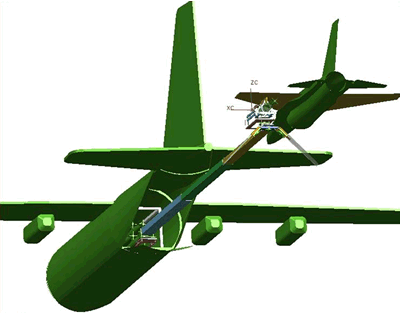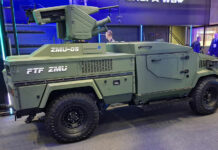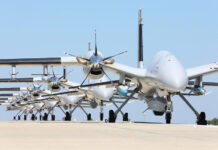FAR Technologies
With the use of massive aerial refueling, sophisticated target acquisition systems, and smart, precision weapons, modern air powers are capable of engaging targets anywhere and anytime. Yet, ordnance release requires terminating the aircraft’s mission to re-arm for the following mission. Flying to and from a distant battlespace poses a “bottleneck” for massive airpower operations.
According to Nir Padan, CEO of the Israeli company FAR Technologies, the Air-Borne Re-Arming concept is real and could dramatically enhance operational tempo of combat aircraft and particularly UCAVs. Israel Aircraft Industries (IAI) and FAR Technologies performed a successful technological feasibility study anddesign of the Air-Borne Re-Arming (ABRA) system. Padansays that airborne rearming could increase the yield from any fleet of strike aircraft, particularly in long range and extended duration missions, typical to those carried out by UCAVs. Padan adds that on the long term, this mode of operation will require less missions, fewer takeoff/landing cycles, resulting in lower maintenance costs. A side benefit will be the improved safety and survivability of the operating bases and carriers.
The system consists of a bomb storage and loading device , attached to a boom at carried by the cargo plane and a smart pylon carried by the attack aircraft, which obtains the weapon from the robotic arm, attaching it to the weapon’s bay or external weapon carrying pylons. An aerial rearming aircraft such as a C-130C, can carry up to 16 MK-84 guided or unguided bombs or considerably more smaller weapons (C-17/5 may potentially carry 4-6 times more). Bombs can be stored in an external or internal bay. The robotic uses an extendable boom, operating from the cargo plane. Controlled by an automatic engagement control (AEC) and supported aerodynamic lift surfaces, the robotic weapon loader will transfer the ordnance from the cargo plane to the attack aircraft. The smart pylon may include sensors and a camera for day and night use. It will interface with the automatic engagement control (AEC) system to automatically activate ordnance on the pneumatic multi-action ejection mechanism and an active sway brace for mid-air operation.
Based on the concept and technology, Professor Asher Tishler, from Faculty of Management, Tel Aviv University, conducted an analysis of the potential contribution of airborne rearming on 3 – 9 hours bombing missions at ranges of 250 to 1,000 nautical miles from the operating base. For UCAVs, 12 – 30 hour mission durations were analyzed.
The analysis demonstrated a dramatic improvement and increase of operational tempo, resulting in the number of attacks executed and target killed without increasing the aircraft fleet. Improvement of up to 100% was demonstrated for short range attacks and over 200% for extended range operations. Since aircraft do not have to return to base to rearm, the density of the attacks could be increased, resulting in faster target neutralization (time required to drop a set number of bombs on target could be reduced by up to 70%). Fielding Airborne Rearming systems could introduce new economies for air forces, where fewer resources can perform more missions, resulting in lower acquisition and maintenance costs. Other attributes of airborne rearming are more flexible use of forward operational bases, (as aircraft can takeoff without loads) and higher survivability of the home base and strike aircraft (reducing pressure from operating bases).




















